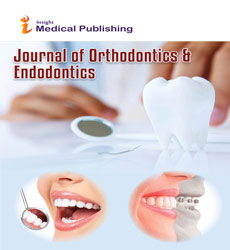Challenges in the Interdisciplinary Treatment of Ortho-Perio Patients
Luca Oliver*
Department of Dentistry,Danube Private University, Krems, Austria
Published Date: 2023-12-11DOI10.36648/2469-2980.9.6.98
Luca Oliver*
Department of Dentistry, Danube Private University, Krems, Austria
- *Corresponding Author:
- Luca Oliver
Department of Dentistry, Danube Private University, Krems,
Austria,
Email: edward@gmail.com
Received date: November 18, 2023, Manuscript No. IPJOE-24-18504; Editor assigned date: November 21, 2023, PreQC No. IPJOE-24-18504 (PQ); Reviewed date: December 04, 2023, QC No. IPJOE-24-18504; Revised date: December 11, 2023, Manuscript No. IPJOE-24-18504 (R); Published date: December 18, 2023, DOI: 10.36648/2469-2980.9.6.98
Citation: Oliver L (2023) Challenges in the Interdisciplinary Treatment of Ortho-Perio Patients. J Orthod Endod Vol.9 No.6:98.
Description
The treatment of ortho-perio patients is really difficult for the interdisciplinary group. In addition to adult patients with obvious perio pathology, any orthopaedic patient, even a young one, can be a perio patient. Determination and hazard evaluation of each ortho-perio patient is fundamental to lay out a right therapy plan, timetable and forecast. Orthodontics turns into a "Perio- Directed" Orthodontic Treatment and Periodontics a "Ortho- Directed Periodontal Treatment". This case report gives a man an exceptionally compromised dentition requesting a total interdisciplinary recovery treated with a consolidated orthoperio treatment in lingual mechanics. The periodontal assessment affirmed the chance of performing orthodontic treatment after dynamic periodontal treatment. Treatment goals were the goal of the swarming, the rectification of the levels of the gingival edge, the bone evening out, the groundwork for helpful spaces; the targets of the last option preceding insert arrangement were: redistribution of space, optimization of the position and parallelism of adjacent teeth, utilization of edentulous sites to correct dental class II, and the use of the fewest possible implants are all methods of treatment.
Gingival Edge
A lingual fixed appliance with miniscrews was used to correct class II division 2 by replacing the upper right first premolar with a canine, retracting the entire upper arch, correcting the deep bite, and optimizing the occlusion after integrating the conventional perio risk assessment with the new Ortho-Perio Risk Assessment (OPRA). Toward the finish of the treatment, the patient had molar connections of class II on the right and class I on the left with a class I canine. Incisal connections were amended, the place of the incisors was enhanced, the spaces in the upper curve were completely settled by orthodontics. During the treatment, orthodontics adjusted the lopsided gingival edge of the front teeth and evened out the bone. Right Ortho-Perio Risk Appraisal (OPRA) is important to design the gamble of articulation of the periodontal aggregate in ortho-patient. OPRA and the lingual mechanics permitted an orthodontic goal of the malocclusion and an improvement of the perio-embed supportive commitments. The malocclusion was fixed by OPRA, periodontal therapy, and lingual mechanics, which improved the restorative peri-implant conditions.
Periodontal Treatment
Orthodontists and periodontists ought to know about the qualities of the singular articulation of the periodontal aggregate toward the start of treatment and include patients in the result, sequencing of consolidated medicines, ortho-perio maintenance and soundness. The treatment of interdisciplinary patients is a test and a valuable chance to work on the collaboration of the dental group. The association among orthodontic and periodontal treatment ought to continuously be remembered for each persistent, paying little heed to progress in years. In the new vision of current epigenetics, increasingly more significance is given to outside variables and propensities that can lead a patient to foster an illness that was dormant and not yet communicated; then again, orthodontics can be a periodontal treatment as well as the other way around. Periodontal treatment may be referred to as "Ortho-Guided Periodontal Treatment," but orthodontic treatment must be diagnosed and carried out as "Perio Guided" orthodontic treatment. According to this viewpoint, it is critical to assess each perspective that can be connected with a general gamble appraisal to foresee future aggregate articulations. The field of periodontology has emphasized the significance of global risk assessment, which includes multiple levels of diagnosis and evaluation for the patient, tooth, and site, in numerous references in the literature. Nonetheless, when we consider the patient according to a periodontal perspective as well as from an orthodontic one, particularly in the interdisciplinary and periodontal orthodontic patient, we want to consider and assess the gamble factors from an ordinary periodontal evaluation as well as from an interconnected ortho-periodontal appraisal and this is by all accounts valid in grown-up and youthful patients, with an individual muscular gamble appraisal.
Open Access Journals
- Aquaculture & Veterinary Science
- Chemistry & Chemical Sciences
- Clinical Sciences
- Engineering
- General Science
- Genetics & Molecular Biology
- Health Care & Nursing
- Immunology & Microbiology
- Materials Science
- Mathematics & Physics
- Medical Sciences
- Neurology & Psychiatry
- Oncology & Cancer Science
- Pharmaceutical Sciences
